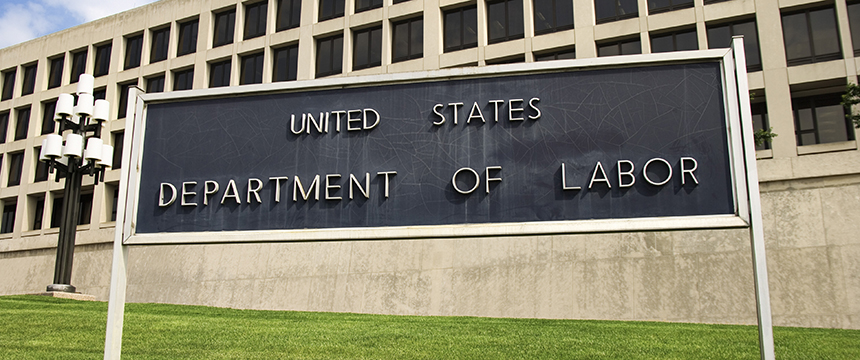The Department of Labor Speaks – New Safe Harbor and COVID-19 Guidance for Retirement Plan Electronic Disclosures

Bottom Line: The Department of Labor (DOL) has released new guidance for retirement plans to meet their ERISA disclosure obligations:
- an additional safe harbor for electronic disclosure of retirement plan ERISA-required disclosures; and
- a “good faith” compliance standard for plan administrators to meet deadlines to furnish retirement plan ERISA-required disclosures during the course of the National Emergency declared related to the COVID-19 pandemic.
Retirement plan sponsors and administrators should take the time now to learn about these new disclosure rules and assess current plan disclosure practices and procedures for compliance. Companies should take the “next steps” (described below) and work with their legal advisors and third-party record-keepers to determine if this new electronic disclosure safe harbor is appropriate for their retirement plans.
Notice and Access – New Safe Harbor for Electronic Disclosures
The DOL recently released a final rule for an additional electronic disclosure safe harbor for retirement plan administrators to meet their ERISA disclosure obligations for plan participants and beneficiaries. This new “notice and access” safe harbor is now available to plan sponsors in addition to the DOL’s other electronic disclosure safe harbors, which were finalized in 2002 (commonly called the “wired at work” and the “affirmative consent” safe harbors). The DOL did make some changes from the proposed rule (published last fall) based on public comments to the proposed rule. But the final rule does not significantly change the fundamentals of the proposed rule (see our earlier article describing the proposed rule in detail).
The key points to know about this new rule to assess whether it may be of interest for your retirement plan:
- May I use the “notice and access” safe harbor for all of my retirement plan disclosures and notices?
No – the new safe harbor applies to “covered documents.” A “covered document” is any retirement plan notice and disclosure that the plan administrator must provide to participants and beneficiaries under ERISA (e.g., summary plan descriptions, fee disclosures, summary annual report, and blackout notices). This safe harbor (similar to the DOL’s other safe harbors) does not currently apply to:
- ERISA-required disclosures that must be furnished to a participant or beneficiary only upon request (e.g., plan document);
- retirement plan disclosures required under the tax rules (e.g., safe harbor notice); or
- disclosures for health and welfare plans.
The DOL did reserve a placeholder for possible future guidance for welfare plans and indicated in the preamble to the final rule that, in response to this new DOL safe harbor, it anticipates future Treasury guidance about electronic disclosure for retirement plans.
- May I use the “notice and access” safe harbor for any plan participant or beneficiary?
This safe harbor applies to any “covered individual.” A “covered individual” is a plan participant, beneficiary or other individual who (i) is assigned a company email address for employment-related purposes, or (ii) affirmatively provides an email or smartphone number to the employer or plan administrator.
In addition, employers will need to maintain appropriate systems and processes to ensure the continued accuracy of the electronic address, including a system for identifying and correcting an invalid address and a reasonable process to obtain a valid/working electronic address from a participant when he or she terminates employment.
- Does the “notice and access” safe harbor eliminate all paper disclosures?
No, but the paper delivery requirements are somewhat limited. Before utilizing the safe harbor for electronic delivery, the plan must notify the “covered individuals” through a paper notification that it is utilizing this new method of electronic delivery going forward. One key change in the final rule is that this initial notice must include the specific electronic address the plan will rely on for that individual, meaning that this initial notice will need to be customized for individuals and cannot be distributed to a new employee until a specific company email address has been assigned to that individual.
In addition, participants and beneficiaries must have the ability, without charge, to opt out of electronic delivery at any time and to request paper copies of any disclosure.
- After the initial notice, what are the company’s ongoing obligations to plan participants and beneficiaries under the new safe harbor?
Once the initial paper notice is distributed, the company must timely (i) post any required disclosures to an accessible website, and (ii) distribute electronically a “notice of internet availability” (NOIA) to covered individuals. The plan must distribute a NOIA each time a covered document is posted; however, certain types of annual disclosures (e.g., SPDs, summary annual reports) may be identified in a single combined NOIA that is distributed on an annual basis. The safe harbor includes a very prescriptive set of content requirements for the NOIA, which the plan administrator must follow for reliance on the safe harbor. Companies that wish to utilize this approach should work with the plan’s third-party service providers to determine how to timely post disclosures to an available website and how to create and ensure timely distribution of NOIAs on an ongoing basis.
- How long do I need to keep disclosures available on the website?
Any disclosure must be maintained on the website for at least one year (or, if later, the date the document is superseded by a subsequent version). Note that notices with a limited applicability or duration, like a blackout notice, still need to be maintained on the website for at least one year while ongoing disclosures, like a summary plan description, will need to be available until an updated version is posted.
Temporary “Good Faith” Compliance Standard for Retirement Plan Disclosures during COVID-19 National Emergency
As part of EBSA Disaster Relief Notice 2020-01, the DOL announced that retirement plan fiduciaries will not be responsible for a delay in providing an ERISA-required disclosure to plan participants and beneficiaries as long as the plan fiduciary acts in “good faith” and furnishes the required disclosure “as soon as administratively practicable under the circumstances.”
- This relief on the timeliness of ERISA disclosures is welcomed by plan administrators dealing with the complexities of workforce changes and remote working due to COVID-19. But, plan administrators should be mindful that this relief is temporary—the relief is available until 60 days after the end of the National Emergency declared due to the COVID-19 outbreak.
- The guidance confirms that the DOL will treat a plan administrator as acting in “good faith” when the plan administrator uses alternative electronic means to communicate with plan participants and beneficiaries, as long as the administrator “reasonably believes” that such individual has effective access to that electronic means of communication, including email, text messages and continuous access websites.
Next Steps
Employees who regularly deal with administration of their company’s ERISA-covered retirement plans should consider the following actions in light of this new DOL guidance:
- Take the time to “get smart” on the various disclosure obligations related to your retirement plans and what rules and new guidance applies to each type of disclosure (including the new DOL electronic disclosure safe harbor and COVID-19-related guidance).
- Assess your company’s current retirement plan communication and disclosure strategies as well as any changing needs in light of changes to your workforce and remote working protocols related to the COVID-19 pandemic. Consider whether the plan may need to rely on the DOL’s temporary relief during the COVID-19 National Emergency.
- Consider what disclosure strategy is the best for your retirement plans and participants or when may be an appropriate time to notify participants about a change in the disclosure process (e.g., during year-end benefit open enrollment periods).
- If you intend to use any type of electronic disclosure method, then determine how the plan will capture valid email addresses or phone numbers from participants and beneficiaries (and how you will ensure the contact information remains valid or is updated on a timely basis, when needed).
- Work with your plan’s service providers to determine how your plan’s record-keeping systems are able to implement an appropriate and compliant approach for furnishing ERISA-required disclosures and monitoring for valid participant and beneficiary contact information.
